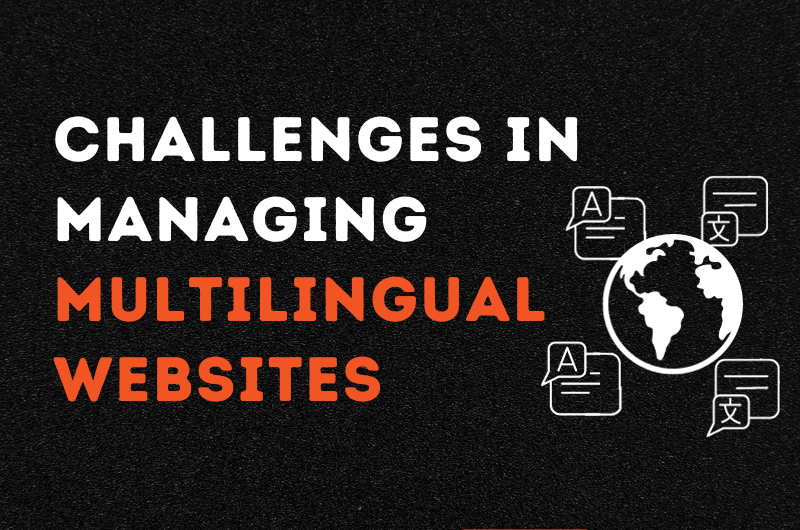Multilingual websites have become the best way to establish your local presence worldwide. They provide countless opportunities for businesses that are looking to expand their options on a global scale. However, developing and managing a multilingual website has many Common challenges. Join us as we explore these complexities in detail.
Get the best website development services in the UK with SEO Syrup.
What are Multilingual Websites?
Multilingual websites allow businesses and companies to use multiple languages to reach a wider audience. They make it easier for their audience to understand the content by translating it for the locals. Such a website sits well with natives of that area and enhances traffic, conversion rate, and leads, ultimately resulting in higher revenues.
Why Have a Multilingual Website?
You might think that having a multilingual website is hard work, and you are right. Just imagine the effort that you would have to put into translating and ensuring that each word accurately delivers your message. It is hard, but it has countless benefits. Here is why you should have a multilingual website:
- Allows you to reach a wider audience.
- Enhances the customer experience and engages people who do not understand English.
- Boosts your sales not only through a wider reach but also through localisation.
- Establishes your brand reputation by showing that you are a global company.
- It provides you with a competitive advantage over your competitors, who are only producing English content.
- Allow search engines to rank you for keywords across multiple languages.
If you want to get more information on multilingual websites, contact us!
6 Common Challenges in Managing Multilingual Websites
You get it: if you are providing content in multiple languages, you will experience a surge in your traffic and revenue. Now let’s get to the difficult part of developing and managing multilingual websites. What are some of the common challenges that you will have to face regularly?
1. Creating a Logical URL Structure
In the modern age, we mostly refer to a business by its identity on the internet, which is the URL. Doing this makes it easier for us to search for them on the internet when we require information or their services. That’s why you need to create a logical URL structure that is not only perfect for your diverse audience but also fulfils technical requirements.
2. Optimising Your Website for Mobile Devices
In addition, you need to realise that most search inquiries are being made from mobile phones. Recognising this, search engines such as Google have also started ranking websites based on their mobile friendliness. Therefore, you must ensure that your multilingual website is optimised for mobile devices.
3. Choosing a Set of Languages
You also need to decide which languages you are going to target. There is no point in writing content for every language in the world. Doing so would only be a waste of time and resources. Analyse your audience statistics and develop a data-driven plan to select the languages. Choose the language that has a larger audience for minimised costs and optimised profit.
4. Implementing a Multilingual CMS
This is the biggest challenge that you are going to face: implementing a multilingual content management system (CMS). CMS is software that allows you to create content for your website while also ensuring user-friendly management. Once you find the CMS of your choice, you have to configure the set of languages while also implementing SEO for different languages.
5. Translating the Content
Translating the content is not as easy as it seems. You might be thinking that you can simply use Google Translate and convert your articles into the language of your choice. Although you can do that, it is not recommended. Translation requires high accuracy, as choosing the wrong phrase might leave the audience completely clueless. It is always a better option to have a language expert who is a native for this purpose.
6. Complying with Legal Procedures
Before you hit that publish button, you have to think twice about whether you are following the law. You might think that it is not much different, but wait until you find out that legal requirements for websites vary from country to country. There is little to be gained from a website that is delisted because it’s not complying with the law. So get a grip on the relevant laws of the countries that you are trying to target.
If you are looking for expert advice on website laws in different countries, talk to our experts.
A Brief Summary
Multilingual websites are a great option for businesses that are looking to expand globally. They not only establish your local presence in other countries but also engage the users with a language they understand. Big companies are doing it, and now so can you, but you will need to be aware of the challenges.
These challenges include creating a logical URL that works for a diverse audience and mobile optimisation. In addition, your content is the heart of your website, so implement an efficient CMS and translate that content accurately. Lastly, ensure that you are not violating any laws, including those of other countries.
We, at SEO Syrup, have extensive experience in developing and managing multilingual websites. Our team of experts ensures that you design a website that is optimised for locals and has the right content. In addition, we also navigate through each law so you don’t get de-ranked. Get an instant quote now!



